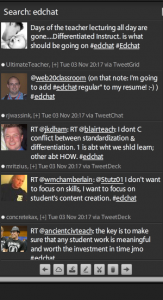
http://edublogawards.com/
Best Resource Sharing Blog
http://dougpete.wordpress.com/
@dougpete
Doug Peterson is the Computers in Education Program Consultant for The Greater Essex County District School Board in Southwestern Ontario. An educator since 1979, Doug has taught Data Processing, Computer Science, Accounting, General Business Studies, and Mathematics at the secondary school level and was the Director of Business Education at Sandwich Secondary School in Lasalle, Ontario.
Best New Blog
http://edvisioned.ca/
@aforgrave
So much of what you write is reminiscent of discussions we had with folks at NECC this past June/July — the PLN movement IS gaining some traction, in no small part due to Twitter and the related social media and 2.0 explosion, but the numbers of folks who are diving in and embracing the concept seem to mirror the rush of the general educational population to embrace technology in general – that is to say, rushing very slowly.
Best Student Blog – Grade Six Student, Lawfield Elementary School
http://allison213.edublogs.org/
The new collaborative test is more for any type of student, independent, talkative, in the middle. It really helps build group and team work skills. Students also get one-on-one learning opportunities with friends and people in their class. With the normal test, most students feel uncomfortable with asking the teacher for help but perfectly fine with asking other students. This test also helps get ideas flowing through students minds. They get up, go sit with a few friends and they all exchange ideas. As long as the teacher goes around and makes sure all the students get the concept, this test would work perfectly in any classroom.
Best individual blog

http://educationaltechnology.ca/couros/
@courosa
In my view, open teaching goes well beyond the parameters of the Free and Open Source Software movement, beyond the advocacy of open content and copyleft licenses, and beyond open access. For open teaching, these are the important mechanisms, processes, and residuals, but they should not be viewed as the end goals in themselves. Rather, open teaching may facilitate our approach to social, collaborative, self-determined, and sustained, life-long learning.
Best educational use of a social networking service

http://makingmakers.posterous.com
@wmacphail
Let me explain. The two classes are collaborating on a multi-part, multimedia project called MakerCulture – Taking Things Into Our Own Hands. It’s a deep, wide exploration of the world of artists, hackers, fabricators, activists and citizens who have decided that a DIY (do-it-yourself) approach to government, software, art, music and hardware is a valid response to global consumerism. It’s a fascinating feature full of astonishing gimcrackery and a sideshow tent full of characters. Great stories, no question.
It will be collaboratively published on rabble.ca and The Tyee. It’s the first time Western and Ryerson have worked together on a joint journalism project, and the first time rabble and The Tyee have co-published as series.
Best Blog Post
http://weblogg-ed.com/2009/the-obama-speech/
@willrich45
My kids both start school on Wednesday, so our schools have avoided all of this. Still, I hope they play the president’s message, regardless of whether it’s a motivational speech to work hard and pursue a love of learning or whether it’s a paean to Stalin, and then engage my kids in conversation about its merits, its flaws and its omissions. And better yet, I hope they take a step back and look at this “controversy” in the context of media analysis, information literacy, political dialogue and debate. Talk about a teachable moment.
But without that, any way you look at it, this is not a great moment for schools.
Best Tech Education Blog
@jswiatek
http://citrushightechnology.com/

Thoughts from a tech specialist…
Daily Bookmark Post 11/21/2009
Posted by Jerry Swiatek on November 21, 2009 |“Want To Try Out Google Chrome OS For Yourself? Here’s How.”
tags: google

